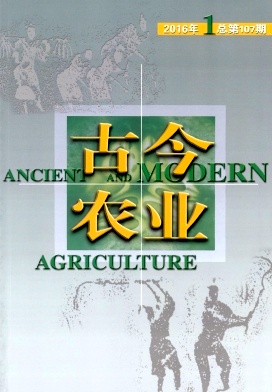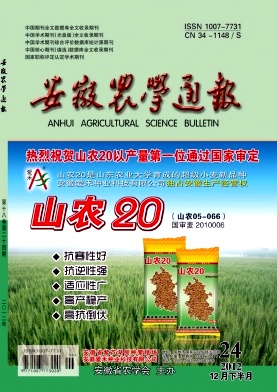作 者:
黄龙;韦木莲;蒙烽;吴雅丽;廖森泰;丁成章;李强;姜鹏
单 位:
佛山市农业科学研究所 / 佛山市农业技术推广中心 / 广东省农业科学院佛山分院;中国水产科学院珠江水产研究所;广东省农业科学院蚕业与农产品加工研究所
摘 要:
[目的]探究基塘农业模式下,不同饲料养殖草鱼的生长性能、常规营养成分和经济效益的差异.[方法]设置蛹肽蛋白饲料组、混合料组、普通料组进行养殖对比试验,每组选择初始体重为770(±11.2)g的草鱼610尾,分别放入面积相同的试验池塘养殖180 d,试验期结束后每组随机抽取4尾草鱼,采集侧线上方背脊肌肉,制成4个质量均为50(±3.8)g的混合样作为每组4个重复,另外试验前随机抽取4尾初始规格鱼种的背脊肌肉制成混合样设置为空白对照.[结果]蛹肽蛋白饲料组草鱼增重率最高(134.3%),肌肉粗脂肪含量(1.74%)显著高于其他组,从增重率与特定生长率两个指标看,均呈现出蛹肽蛋白饲料组>普通料组>混合料组的显著性差异;混合料组的草鱼粗蛋白含量(20.7%)和鲜味氨基酸含量(6.37%)均最高,而脂肪含量最低(1.27%),投入产出比最低(0.941).初始组不饱和脂肪酸含量(71.07%)显著高于3个试验组,3个试验组草鱼肌肉油酸(C18:1)含量与氨基酸总量均高于初始组,蛹肽蛋白料组与普通料组的鱼肉营养成分无显著差异.[结论]摄食蛹肽蛋白饲料的草鱼增重率高,但容易沉积体脂,导致体型肥胖;混合料组的草鱼生长速度慢,但鱼肉粗蛋白含量最高(20.7%),脂肪含量最低(1.27%),肉质更鲜美.基塘农业模式下利用闲置区域种青养鱼,能有效降低饲料成本,改善鱼肉品质.
译 名:
Analysis on the Effects of Grass Carp Fed with Different Feed Based on Dike-pond Agriculture
作 者:
HUANG Long;WEI Mulian;MENG Feng;WU Yali;LIAO Sentai;DING Chengzhang;LI Qiang;JIANG Peng;Foshan Sciences of Agricultural Institute/Agricultural Technology Extension Center of Foshan/Foshan Branch, Guangdong Academy of Agricultral Sciences;Sericulture Institute & Agri-Food Research Institute, Guangdong Academy of Agricultural Sciences;Pearl River Fisheries Research Institute,Chinese Academy of Fishery Sciences;
关键词:
dike-pond agriculture;;grass carp;;pupal peptide protein;;jean grass
摘 要:
【Objective】The study was conducted to explore the differences in growth performance, conventional nutrient composition and economic benefits of grass carp cultivated with different feed based on dike-pond agriculture. 【Methods】A comparative test on grass carp breeding among three groups, i.e. pupa peptide protein group(PP. Group), pupa peptide protein feed and jean grass group(PP.+JG.Group), feed from WangHai corp.(WH. Group). 610 grass carps with the initial weight of 770(±11.2) g were selected for each group and were cultured in the test ponds of the same size(0.147 hm2) for 180 d. At the end of test period, 4 grass carps were randomly selected from each group, and dorsal muscle above the lateral line were collected and made into 4 compound samples with a mass of 50(±3.8) g as 4 repeated samples in each group. In addition, the dorsal muscle of 4 grass carps with the initial weight was randomly collected before the test to be made into compound samples as the blank control group. 【Result】The results showed that the grass carps in PP. Group have the highest weight gain rate(134.3%), and the crude fat content in muscle(1.74%) was significantly higher than that of other groups. From the two indicators of weight gain rate and specific growth rate, there was an obvious difference among 3 groups: PP. Group >WH.Group>PP.+ JG. Group. The crude protein content(20.7%) and delicious amino acid content(6.37%) of grass carps in PP.+JG.Group were the highest, while the fat content was the lowest(1.27%), and the input-output ratio was the lowest(0.941). The unsaturated fatty acid content(71.07%) of the initial group was significantly higher than that of three test groups(66.98%, 65.48%, 66.07%); while the oleic acid content(C_(18:1)) and total amino acid content in the muscle of grass carps in the three test groups were significantly higher than those in the initial group, and there was no significant difference in the fish nutritional composition between PP. Group and WH.Group.【 Conclusion】Grass carps fed with pupa peptide protein feed had a high rate of weight gain, but it was easy to cause body fat deposition. Grass carps of PP.+JG.Group grew slowly, but the fish had the highest crude protein content(20.7%) and the lowest fat content(1.27%), and higher delicious amino acid content. Raising grass carp with grass based on dike-pond agriculture in the idle areas can effectively reduce the cost of feed and improve the fish quality.






